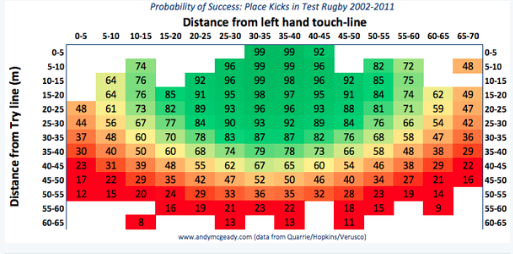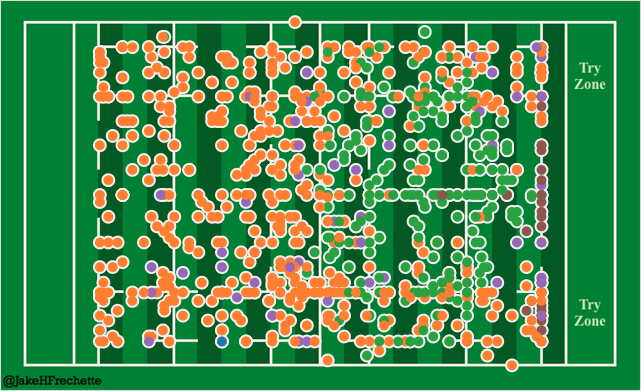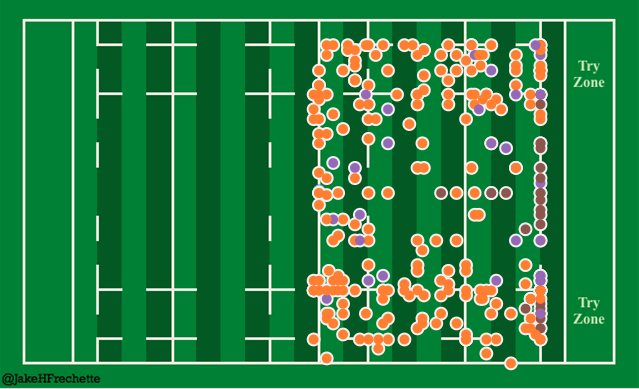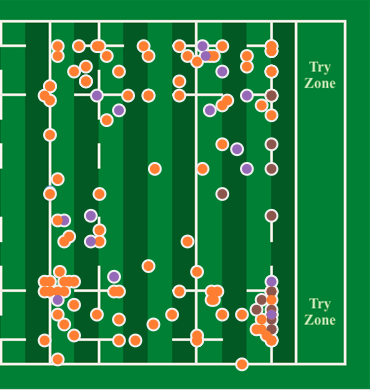
PHILADELPHIA, PA – Oooh, let’s talk some numbers! My reaction to “Why rugby teams should go for penalties not tries” from the Economist by J.T. is delayed only because I didn’t see it until yesterday. It is worth looking at thoughtfully.
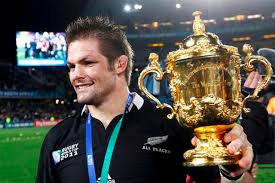
Here is the central conclusion: “Thus, whether you are mighty New Zealand or plucky Namibia, against a Tier 1 side you should call for the kicking tee 99 times out of 100 when awarded a penalty in the opposition half.”
That conclusion is supported by working out how many lineouts and scrums from inside the 22 lead to tries. The total number of points scored from those tries divided by the number of scrums or lineouts gives an expected return from a scrum or a lineout inside the 22 against a Tier 1 side.
The most important thing about this post is the belief that captains should be making fully informed decisions rather than following some sort of instinct. That I agree with without hesitation. I have written about this kind of thing in the past.
The conclusion that the penalty goal from anywhere inside the attacking half is nearly always the right one whenever playing a Tier 1 side, though, is flawed.
Before looking at that conclusion, let’s acknowledge how relatively rare it is for a side to be playing a Tier 1 nation. It is true that the post makes no claims about club rugby or of the sides of lesser rugby nations. However, the post’s intentionally narrow focus means that its applications are accordingly narrow.
That’s not bad, but as someone who enjoys club rugby immensely and whose national side is more likely to be playing someone other than a Tier 1 nation, the conclusions aren’t relevant to most of the games I care most about. Still – the thought process behind the conclusion should not be ignored.
Let’s look at the details of the post.
“After a major infringement by the opposition, a captain has a number of options available—and in some positions, none of them are particularly appealing. If the penalty is on the touchline, then trying to slot the ball between the posts is difficult. And even if it is successful it will only earn three points. Opting for a scrum or kicking the ball into touch for a lineout gives a team the chance to run in a try worth five points (or seven if the try is converted), but the chances are slimmer.”
Ignored here is the quick tap, or even just a tap. More on that in a bit. The other thing that is not acknowledged here is that the outcome from a scrum or a lineout is not binary (try/no try). For instance, against Australia, Scotland were awarded a penalty in the 67th minute. The spot was about 48 meters from the try line and 25 meters from the center of the pitch. According to the conclusion in the post, Scotland’s kick to touch which resulted in no try was the wrong decision. Not so fast.
No try was scored. However, following the lineout, Scotland were awarded another penalty; this one was from a much easier position to make the penalty goal.
According to this chart made by Andy McGeady using data from Quarrie/Hopkins/Verusco, the chance of 3 points was moved from 21% to 95%. That’s a good outcome. And indeed, the penalty goal was made.
A similar situation occurred in Ireland’s loss to Argentina this weekend. Ireland were awarded a penalty just on halfway. They kicked to touch and ended up with a penalty from a much handier position. The 3 points were gained as a result of the first “riskier” decision.
Related…
“Data from goalkickers.co.za calculates the probability of any particular kick going through the posts, depending on distance, angle and the skill of the penalty-taker.”
Sort of. The kick’s probability according to Goalkickers is measured against the average professional kicker. Greig Laidlaw’s probability would be a bit higher than average because he is a good kicker. He is a good kicker who typically does not take low-percentage kicks.
That leads to…
“Of 460 kicks attempted at this tournament, only five have fallen below the 30% threshold.”
Okay. That by itself doesn’t indicate that teams aren’t attempting enough penalty goals. What do we know about the kicks not taken? That 5 attempts below 30% might just indicate that teams are already making good decisions and don’t attempt penalty goals when they shouldn’t. Of course Laidlaw and other smart captains are choosing not to take the kicks with such a low probability. That doesn’t tell us how likely they would be to make the kicks that never became kicks.
Let’s look at all of the penalties from all 40 matches of pool play. Click on this link to interact with the map.
Here is the screen shot of every penalty from the pool stages of the 2015 Rugby World Cup, which are the matches J.T. is writing about in his post.
That is too much to make sense of.
Here are just the penalties in a plausibly “kickable” position that were not penalty goal attempts.
Already, we can see things thinning out in the center of the pitch.
And here are just the instances when the attacking team was either ahead or behind by 10 points or fewer – that is, when the match was reasonably close.
Many of those dots could have become 3 points realistically. Many of those would have been tough kicks. You can sort further by score and time to really see how many of the decisions were poor and how many were teams doing things like going for bonus points.
Back to “Why rugby teams should go for penalties not tries”:
“The Welsh, who have been goaded by the Australians about their dull “northern hemisphere preference” for using the boot, would most likely have beaten their tormentors if they had attempted more than three out of 10 penalties in the Wallabies’ half. (Australia called for the tee on seven out of eight opportunities, succeeded five times, and secured a much easier route to the final.)”
The Welsh are coached by a New Zealander who might still have some southern hemisphere preferences, but we’ll leave that aside. More important is that several (5) of those 10 penalties came in a bunch. I actually marked one of the 10 penalties occurring just on the other side of halfway with Dan Biggar striding over as he kicked to touch. According to my records, 3 of 9 penalties became penalty goal attempts.
Whether 9 or 10, it is true that sides often fail to reassess as situations change (“We went for the try 30 seconds ago, so dagnabit, we’re a-goin’ again!”), but the penalty count would have been different, and the ratio different, had they taken the penalty goal attempt at minute 57 – the first of the bunch.
Presumably, the yellow cards awarded during that passage of play also changed the probabilities, but we don’t have enough data to really know how much.
Another factor to consider is whether or not forcing the opposition to make lots of tackles increases the likelihood of tries. I hope to look into that next week, but suspect someone out there already has a pretty good answer I just haven’t seen yet. Feel free to point me in the right direction.
One thing that the post is clearly correct about is that good teams are extremely organized in defense from scrums and lineouts. Predictability an attack is met by organized defense. Teams in attack create opportunities by creating and exploiting situations when the defense lacks organization. Taking a penalty quickly is a chance to attack a defense when it is less than fully organized.
The quick tap seems an under-utilized option from penalties inside the 22.
To make the best decision, a captain needs to know the expected outcome of all possibilities. How likely is his side’s kicker to make the kick? How much territory will be gained from the kick to touch? How likely are they to win the lineout? How likely are we to win more penalties in our opponents half? And so on, and so on.
More informed decisions are good; looking to make something complicated simple is not.
J.T.’s post has added to the conversation, but there is still lots more to talk about.
That’s it… Feel free to comment below, look for and “Like” our Facebook Rugby Wrap Up Page and follow us on Twitter@: RugbyWrapUp, Jake Frechette, Junoir Blaber, James Harrington, Jamie Wall, Nick Hall, DJ Eberle, Scheenagh Harrington, Jamie Loyd, Cody Kuxmann, Karen Ritter, Audrey Youn, Akweley Okine, Rocky Brown and Declan Yeats, respectively.


